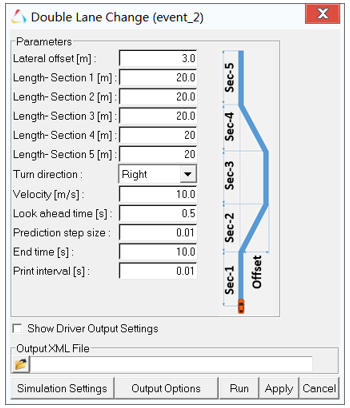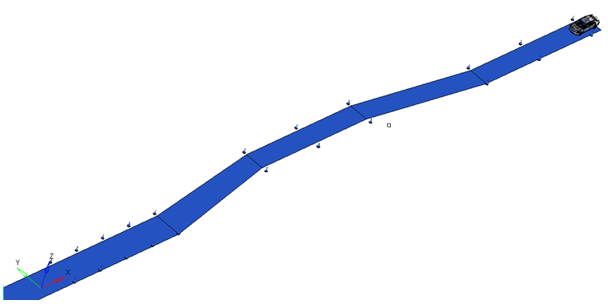Double Lane Change
A Double lane change event drives the vehicle through a lane change and a return to lane maneuver, attempting to follow the centerline of the defined lane.
You can define the speed of the lane change, along with the lane dimensions. The Altair Driver model is used to maintain speed throughout the event. The event supports right and left lane changes. A plot template is available to plot the results.

Figure 1. Double Lane Change - Path

Figure 2.
| Parameter | Description |
|---|---|
| Lateral offset | Offset distance (meters) of the double lane change. |
| Length- Section 1 | Length of the initial straight section of road, in meters. |
| Length- Section 2 | Longitudinal Length of the initial lane change section of road (meters). |
| Length- Section 3 | Length of the center straight section of road (meters). |
| Length- Section 4 | Length of the second lane change section of road (meters). |
| Length- Section 5 | Length of the recovery section of road (meters). |
| Turn direction | Direction the vehicle turns during the event (as seen by the driver). |
| Velocity | The initial speed of the vehicle (miles per hour). |
| Look ahead time | Look ahead time used by the Altair Driver. |
| Prediction step size | Maximum step size that the solver can take, in seconds (if the number is .02, maximum step size is .02 seconds). |
| End Time | Absolute end time of the event, in seconds. |
| Print interval | Data is output to the plot files and graphics file at this time interval (seconds). |

Figure 3.
References
ISO 3888-2-2011 Passenger cars — Test track for a severe lane-change maneuver.
NATO Allied Vehicle Testing Publication AVTP: 03-160 Sep. 1991.